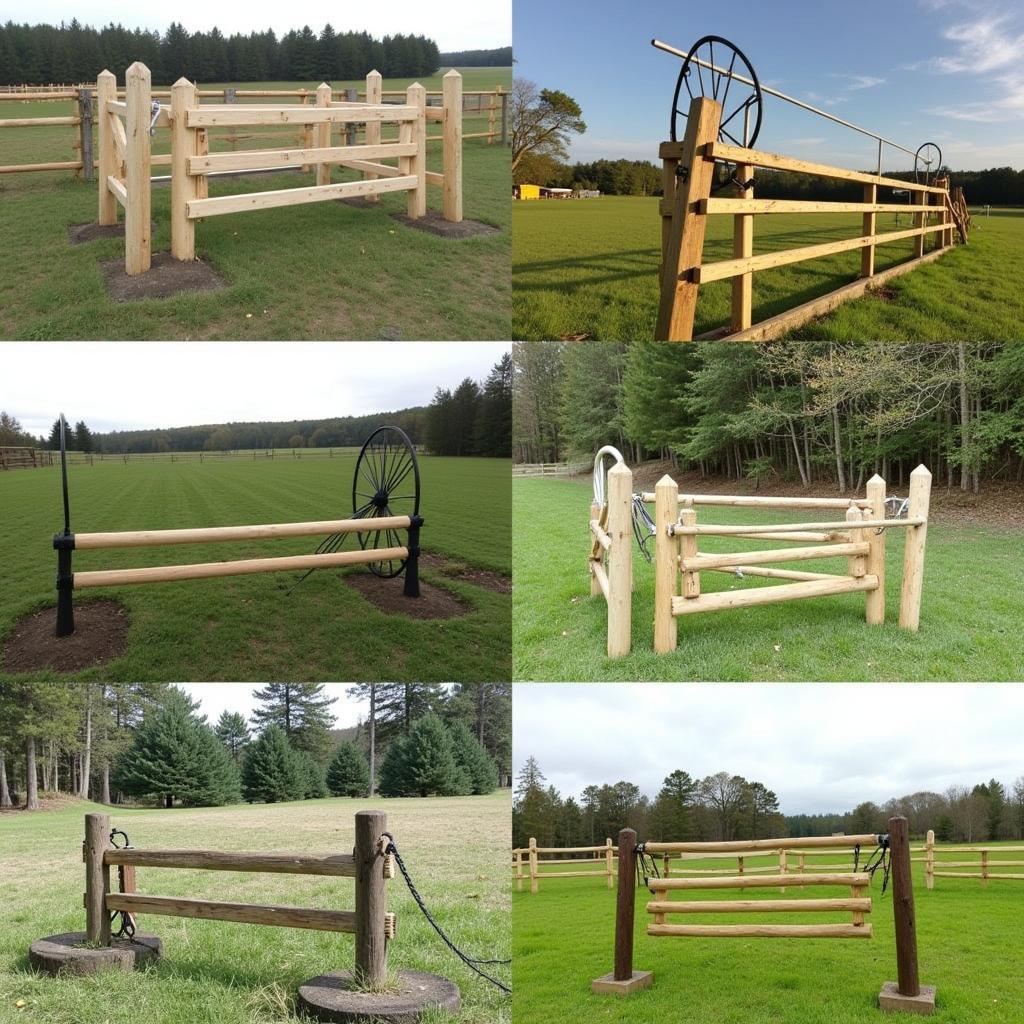A Horse Hitching Rail is a seemingly simple structure, but it’s a crucial piece of equipment for any horse owner. Whether you’re trail riding, attending a show, or simply visiting a friend with your equine companion, a reliable hitching rail ensures the safety and security of your horse. This guide will cover everything you need to know about horse hitching rails, from choosing the right materials to proper installation and maintenance.
Choosing the Right Horse Hitching Rail Material
Selecting the appropriate material for your horse hitching rail is essential for its longevity and functionality. Several popular options exist, each with its own pros and cons:
- Wood: Classic and aesthetically pleasing, wooden hitching rails blend seamlessly into most environments. Choose durable hardwoods like oak or cedar for weather resistance.
- Metal: Metal hitching rails, particularly those made of galvanized steel or powder-coated aluminum, are incredibly strong and require minimal maintenance. They offer excellent durability and can withstand harsh weather conditions.
- Composite: Composite materials combine the best of both worlds, offering the look of wood with the durability of metal. They are resistant to rot, insects, and weathering.
After carefully considering your individual needs and the specific environment where the hitching rail will be installed, you can make an informed decision that ensures both functionality and aesthetic appeal. A well-chosen hitching rail is an investment that will serve you and your horses well for years to come.
Considering your horse trailer storage ideas might also influence your decision on the type of hitching rail you choose.
Installing Your Horse Hitching Rail
Proper installation is crucial for a secure and safe horse hitching rail. Whether you’re working with wood, metal, or composite materials, ensuring stability is paramount. Here’s a step-by-step guide:
- Choose the location: Select a level, well-drained area with ample space for your horse to stand comfortably.
- Prepare the ground: Dig holes for the posts, ensuring they are deep enough for stability.
- Set the posts: Place the posts in the holes and fill with concrete, making sure they are plumb and level.
- Attach the rails: Securely attach the rails to the posts using appropriate hardware.
- Finishing touches: Add any decorative elements or safety features, such as rings or quick-release snaps.
Maintaining Your Horse Hitching Rail
Regular maintenance will prolong the life of your hitching rail and ensure the safety of your horses.
- Wood: Apply a weather-resistant sealant annually to protect against rot and insect damage.
- Metal: Check for rust and corrosion, and touch up any affected areas with appropriate paint.
- Composite: Clean regularly with soap and water to remove dirt and debris.
By following these simple maintenance steps, you can keep your hitching rail in excellent condition for years to come. A well-maintained hitching rail not only enhances the safety of your horses but also adds to the overall aesthetic appeal of your property. Remember, a sturdy and reliable hitching rail is an essential investment for any responsible horse owner.
“Regular maintenance is key to ensuring the longevity of any hitching rail, regardless of the material,” advises Johnathan Miller, an experienced farrier from Kentucky.
Different Types of Horse Hitching Rails
Beyond material, hitching rails come in various styles, each with unique benefits.
- Straight rails: Simple and functional, providing a secure tie-point for multiple horses.
- Wheel rails: Offer a decorative touch while providing ample tying space.
- Portable hitching posts: Ideal for temporary use, such as trail riding or camping. You may want to consider two wheeled carts for horses for transporting gear on your trail rides.
Selecting the right type depends on your individual needs and preferences. Understanding the various options available allows you to make an informed decision that meets the specific requirements of your horses and your property.
Knowing how to replace parts like a horse trailer jack replacement can be useful when maintaining your horse trailer. Similarly, understanding the different types of hitches, like a horse trailer gooseneck hitch, is important for safe towing.
 Different Styles of Hitching Rails
Different Styles of Hitching Rails
“Choosing the right style of hitching rail can significantly enhance the functionality and aesthetic appeal of your property,” says Dr. Emily Carter, DVM, from Montana.
Conclusion
A horse hitching rail is an essential piece of equipment for any horse owner, ensuring the safety and security of your equine companion. From selecting the right material and style to proper installation and maintenance, every aspect contributes to a reliable and long-lasting hitching rail. By investing in a quality hitching rail, you are investing in the well-being of your horse.
FAQ
- What is the best material for a horse hitching rail? The best material depends on individual needs and preferences. Wood, metal, and composite materials all offer unique benefits.
- How do I install a horse hitching rail? Proper installation involves choosing a suitable location, preparing the ground, setting the posts, attaching the rails, and adding any finishing touches.
- How do I maintain a horse hitching rail? Regular maintenance, including cleaning and sealing, is essential to prolong the life of your hitching rail.
- What are the different types of horse hitching rails? Common types include straight rails, wheel rails, and portable hitching posts.
- Where can I find more information about horse care? Check out our article on Horse Thief State Park for more information on horse-friendly locations.
For further assistance, please contact us at Phone Number: 0772127271, Email: [email protected] Or visit us at QGM2+WX2, Vị Trung, Vị Thuỷ, Hậu Giang, Việt Nam. We have a 24/7 customer service team.